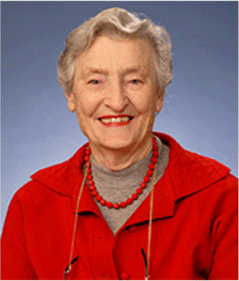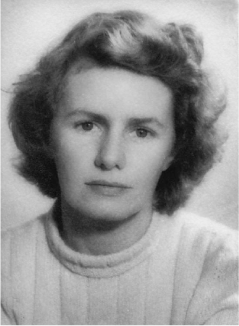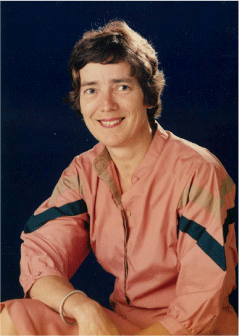Breaking down barriers: standing on the shoulders of Australia’s early female chemists
Nicole McNamara A , Anitha Kopinathan
A , Anitha Kopinathan  B , Helen Wolff
B , Helen Wolff  C , Thomas H. Spurling
C , Thomas H. Spurling  C , Gregory Simpson C and Katherine E. S. Locock
C , Gregory Simpson C and Katherine E. S. Locock  A *
A *
A Manufacturing, CSIRO, Research Way, Clayton, Vic. 3168, Australia.
B Medicinal Chemistry, Monash Institute of Pharmaceutical Sciences, Monash University, Parkville, Vic. 3052, Australia.
C Centre for Transformative Innovation, School of Business, Law and Entrepreneurship, Swinburne University of Technology, Hawthorn, Vic. 3122, Australia.
Australian Journal of Chemistry 76(2) 63-73 https://doi.org/10.1071/CH22235
Submitted: 10 November 2022 Accepted: 21 December 2022 Published: 10 February 2023
© 2023 The Author(s) (or their employer(s)). Published by CSIRO Publishing. This is an open access article distributed under the Creative Commons Attribution-NonCommercial-NoDerivatives 4.0 International License (CC BY-NC-ND)
Abstract
Women experience numerous forms of discrimination in the workplace, both direct and indirect. Historically, bias against women was institutionalised by organisations and governments to keep women from pursuing long-term careers in science and remain in the home. Although changes to policy have occurred within Australia, societal perceptions around women in science have proven resistant to change, with discrimination continuing even today. Despite the barriers facing them, some women were able to break through and achieve impactful science, proving themselves vital members of the workforce and paving the way for future generations. Herein, we describe four such female chemist trailblazers, Isabel Joy Bear, Enid Plante, Catherine Anne Money and Annabelle Duncan, who each worked at the Council for Scientific and Industrial Research (CSIR) or the subsequent Commonwealth Scientific and Industrial Research Organisation (CSIRO) and helped to shape the face of chemistry in Australia in a male dominated environment.
Keywords: chemistry, CSIRO, diversity, history of science, inclusion, STEM, women.
Introduction
Historically, women have faced various forms of discrimination in the workplace, often institutionalised by their organisation or even by legislation. Direct discrimination, which occurs when a person is treated less favourably due to personal characteristics or background,[1] was once a common method used to discourage women from pursuing positions in science. This, aligned with past societal beliefs that considered scientific work as ‘men’s work’ and non-scientific work as ‘women’s work’, upheld men ‘as the norm in science’.[2]
One devastating example of direct discrimination was the Public Service Act of 1922, which included explicit terms relating to a marriage bar in Section 49: The Act stated, ‘No married woman shall be eligible for employment in the Commonwealth Service unless there are special circumstances that make her employment desirable’ and ‘every female officer shall be deemed to have retired… upon her marriage’.[2,3] This Act hence served as one of the greatest barriers to the employment and progression of women in Australian public service institutions. The Act reflected the dominant ideology in the society at the time that strongly discouraged the employment of married women. Married women were viewed as ‘taking the jobs of men who had greater need of the salary’,[2] as it was expected that it was the man who would need the job to support a family. Furthermore, discussed in her MA thesis, Alvarez cites that Senator R. V. Keene called for a ‘combing out of married women’ in parliament in 1939.[2] This viewpoint was slow to change; by the early 1960s it was still the opinion of the Australian Cabinet that ‘the Commonwealth Government should not lead in encouraging women away from their homes and into employment’, as cited by Sawer.[4,5] Encouraging married women to leave the public service also correlated to a significant loss of valuable knowledge and talent that these women offered. Even single women suffered under this Act, often missing out on training as it was expected ‘they would marry and thus waste….extra knowledge or skills they picked up’.[4] This so called ‘marriage bar’ remained in effect until 1966, when it was finally abolished.[4]
Technically, Australia’s National Science Agency, the Council for Scientific and Industrial Research (CSIR, 1926–1949) and the subsequent Commonwealth Scientific and Industrial Research Organisation (CSIRO) were not beholden to this Act. Under the Science and Industry Research Act (1926) section 14A (2), ‘Officers employed under this Act shall not be subject to the Commonwealth Public Service Act 1922–1924, but shall be engaged for such periods and shall be subject to such conditions as are prescribed.’[6] When CSIR transitioned to become CSIRO, the corresponding Science and Industry Research Act (1949) added a condition in 22 (1) stating that ‘Officers shall not be subject to the Commonwealth Public Service Act 1922–1948 but shall hold office on such terms and conditions as are, subject to the approval of the Public Service Board, determined by the Executive.’[7] CSIR/CSIRO generally conformed to the principles underlying the Act. However, it was prepared to ignore the Act when the senior management wanted to employ or retain a high performing female scientist.[8,9]
Despite this, there remains evidence of direct discrimination against married women in the early history of CSIR/CSIRO.[2] Fig. 1 shows that while married women did appear to be employed by the organisations over this period, their proportion remained low and relatively stable until the abolishment of the marriage bar. It would have been difficult for women at the time to dream of a long-term career at CSIR/CSIRO. Following the abolishment of the marriage bar, there appears to have been more retention of married women in the CSIRO, with the number of married women employed at CSIRO doubling from 25.7 to 53.5% over a 10-year period (1964–1974). However, even with the removal of this significant direct discrimination barrier, there was still very little impact to the overall representation of all women in the organisation’s workforce, with women constituting only 6% of employees as seen in Fig. 2.[10] This data reflected all female staff employed during this time period, both research and support staff. It is clear that there remained significant barriers for women wishing to engage in a career in science at CSIRO. Women’s numbers have continued to grow at CSIRO since this time, proving them to be crucial members of the workforce. CSIRO has continued to improve female representation, to a total of 32% of its research workforce in 2016.[11]
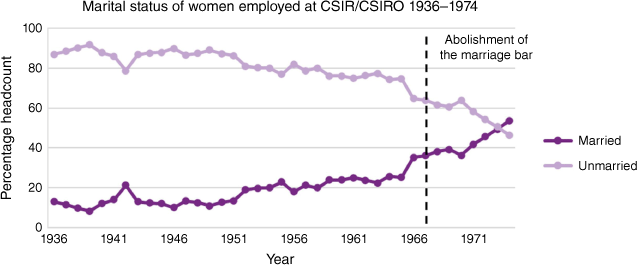
|
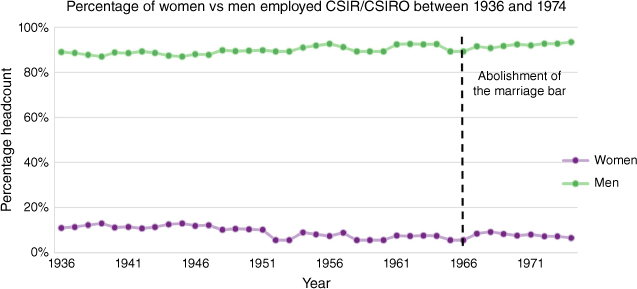
|
Another damaging form of direct discrimination against women was the gender pay gap. Prior to the establishment of the Women’s Employment board in 1943, women had been receiving around two-thirds or less of the male wage for performing the same job. The board secured women 75% of the male wage when performing the same job. It was not until 1972 that the Conciliation and Arbitration Commission ruled that men and women undertaking similar work were eligible for the same pay rate. This decision only applied to women working under federal conditions and awards. This was extended in 1973, granting an equal minimum wage to all Australians, regardless of gender.[12] However, the matter of equal pay remains an ongoing issue today. As of May 2022, the Australian Bureau of Statistics indicates that the gender pay gap is at 14.1%, with full time earnings for males being higher than their female counterparts.[13]
While many forms of direct discrimination such as the marriage bar, differential pay and superannuation,[5,12,13] have been removed for women wishing to engage in a career in science, indirect discrimination has persisted.[14] The major barriers women face today are more covert. Indirect discrimination occurs when an unreasonable rule that is the same for everyone has an unfair effect on a people sharing a particular attribute.[15] Kopinathan et al. previously summarised four specific barriers to women’s career progression in chemistry: workplace culture, work–life balance, measures of merit and mentorship[16] along with practical strategies to help navigate these challenges. These were based on data obtained through the Academy of Sciences Women in STEM Decadal plan[17] and are briefly described below:
Workplace culture: The beliefs, values, expectations and assumptions shared by staff which are mirrored in their behaviour and interactions with others.[16] Bullying, discrimination and harassment towards women are widespread in STEM workplaces. Although men are also subjected to these issues, women are impacted at a higher rate.[16–18]
Furthermore, unconscious bias and upholding the status quo in hiring and promotion or award cases can lead to a propensity for individuals to favour those that are like themselves.[16,19] This is particularly an issue for women in senior roles ‘who remain under-represented in positions of power and authority’.[19]
Work–life balance: The harmony between non-work and work commitments. Women are disproportionally impacted, as caring responsibilities for children, parents or disabled dependants often fall on them. This can adversely affect their quality of life or require them to abandon important commitments.[16]
Measures of merit: Recruitment, awards, promotions and other forms of recognition of past performance and future potential. These processes can be inherently gendered, allowing for men with fulltime, uninterrupted careers to be advantaged over women, who are more likely to experience career interruptions.[16]
Mentorship: A partnership where a generally more experienced person provides support and guidance to a less experienced person. The mentor may provide that mentee encouragement or opportunity to develop new skills and fast-track career progression.[16] Mentorship programs and visible role models can impact career advancement. However, the ‘face’[11] of science is predominately thought of as ‘middle-aged Caucasian men’,[16] with staff at CSIRO noting they ‘have relatively few female role models’.[11] Informal networks that may act as a source to access mentorship or role models can pose a challenge for females in male dominated environments. Exclusion from these male-only networks, or ‘Boys Clubs’,[16,19] can further disadvantage women’s career progression.[16]
Despite these barriers, along with the blatant, direct discrimination previously faced, women have continued to break through and deliver impactful science. With each generation, we see the playing field inch closer to an equitable workplace. Thus, female chemists today have a lot to learn from the adversity faced by their predecessors. It is their stories that have paved the way for future generations of female chemists. Herein, we highlight the stories of four such trailblazing women of chemistry from CSIR/CSIRO.
Isabel Joy Bear (1927–2021)
Dr Isabel Joy Bear (1927–2021, active service: 1944–1950, 1953–2015) was a prominent Australian chemist in the field of solid-state chemistry and metallurgy.[20] According to Joy, her passion for science was spurred by her high school mathematics and science teacher, who sparked her initial interest in astronomy.[21] Her niece, Dianne Wright, states that Joy was actively discouraged from pursuing a tertiary degree by her father stating, ‘it would be wasted on Joy’.1 However, Joy’s passion for science subsequently led to an illustrious career in chemistry, spanning over seven decades at CSIRO (Fig. 3).
Joy had developed a strong ambition to be a research scientist but was unable to afford a university education. As such, she commenced at CSIR as a very low-level Junior Laboratory Assistant in the Minerals Utilization Section of the Division of Industrial Chemistry at the age of 17. At the same time as this, she also undertook part-time study at night for two Associate Diploma courses (Applied Science and Applied Chemistry) at Melbourne Technical College. She did this, believing that it would allow her to finally enter the ranks of research staff in the Division as she desired.[20]
Despite this commitment, Joy’s advancement through the scientific ranks within CSIR were marred by problematic workplace culture and perceptions of merit. Long held values, beliefs and assumptions about the limitations of a woman’s scientific capabilities, and their abilities beyond acting as laboratory support staff were commonplace. For instance, during her work with Western Mining at Broken Hill, she was not permitted to collect her own samples ‘because it was considered bad luck for women to go below the surface’.2 Additionally, there was a long-held belief within CSIRO that scientists were most productive before they reached the age of 40, and as such, a scientist would never be reclassified to the research staff beyond this age.[20]
These entrenched workplace beliefs were particularly rife in 1967, when Joy sought a reclassification from an Experimental Officer to join the research staff as a Research Scientist. She reached out to a former collaborator, for a reference to support her case. Although he was complimentary of Joy’s scientific skills, even crediting her with having done ‘practically all the work on petrichor on her own’,3 the collaborator felt that he was unable to wholeheartedly endorse Joy’s promotion. In his reference letter to Mr Ivan Newnham, the Chief of Division, Joy's former collaborator felt that as a woman, Joy may not be up to the task of being a truly innovative and independent researcher, writing; ‘Although it is an invidious thing to say I have never thought that women have the same capacity for original thought and particularly what I would call ‘inventive capacity’ compared with men’.4 Thankfully Joy had the full support of Mr Newnham, who successfully argued her case before the CSIRO executive and won her reclassification. In Joy’s own words her promotion was due to the ‘moral courage of [her] Chief of Division (Mr Newnham)’, and his belief that her independent work on metastable metal hydrates warranted promotion to research level ‘despite [her] sex and [her] mature age (40)’.[21] Unfortunately Joy’s promotion seemed to be an exception during this period and such career advancement was not afforded to any other women within the Division of Mineral Chemistry over the years of its existence (1959–end of 1987).[20]
Despite her struggles around the workplace culture and measures of merit at that time, Joy’s determination, enthusiasm and passion for science allowed her to overcome significant barriers and workplace biases. Joy made many contributions to solid state and mineral chemistry. Most notably, in collaboration with Dr Richard Grenfell Thomas, Joy is attributed with the chemical characterisation and naming of ‘petrichor’ (the ethereal fluid of the rocks) – the volatile substance produced in the air following rainfall which is associated with the characteristic smell of rain. Lipids, terpenes, carotenoids and other volatile decomposition products from animal and vegetable matter are absorbed by rocks and clays. The odorous and volatile products of these processes are subsequently displaced from the pores of the rock by moisture when the relative humidity of the atmosphere approaches saturation. This produces ‘the smell of rain’.[22–24]
Joy went on to earn a number of distinguished fellowships and awards, including the Victorian Honour Roll of Women, the Leighton Medal (the Royal Australian Chemical Institute’s premier award) and the Member of the Order of Australia for her services to science in the field of mineral chemistry.[20] Current CSIRO employees describe her as ‘[leading] the charge for the rest of us’ and ‘an inspiration to women, to anyone who fought for fairness’.[25]
While we could hope that opinions have changed regarding the ‘inventive capacity’ of women, recent data does indicate that more males were awarded promotions at CSIRO between 2014 and 2016. In addition, women were also less likely to apply for a promotion compared to men. Female research staff in particular expressed reluctance to apply for senior research management positions, describing these roles as ‘undoable and undesirable in their current states.’[11] While this is likely a product of a complex mix of variables, it could contribute to the larger representation of women at lower CSOF levels, shown in Fig. 4.
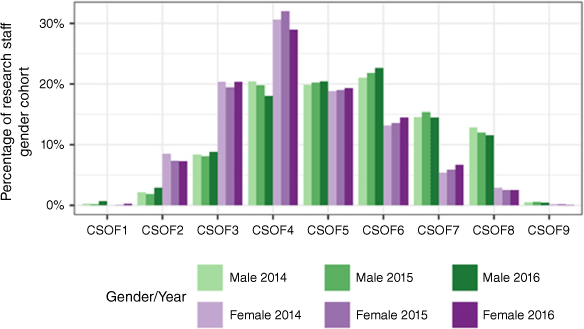
|
The Science in Australia Gender Equity (SAGE) Athena SWAN Institution Application submitted by CSIRO in 2018, reported that female research scientists/engineers were most likely to hold positions between CSOF 4 and 6 during 2014–2016, with a significant drop in the percentage of female research staff occurring between CSOF levels 6 and 7 (13.8–6.0%), depicted in Fig. 4. With respect to mapping research staff at CSIRO against academic levels, CSOF4 ≅ Level A; CSOF5 ≅ Level B; CSOF6 ≅ Level C; CSOF7 ≅ Level D; CSOF8 ≅ Level E.[11]
A drop is also observed in the percentage of male research staff between CSOF levels 6 and 7 (21.9–14.8%), although the percentage of males at CSOF7 was noted to be higher than that of female research staff at CSOF level 6.[11] Internal recruitment data suggests ‘when a female did apply for a CSOF6+ research position, she was just as likely to be successful as a male applicant’,[11] however by headcount more males were still appointed.[11] Consistent with external data, evidence at CSIRO suggests women are less likely to compete than men, particularly if the position is widely advertised and perceived as more competitive.[11]
Enid Plante (1918–2007)
Enid Campbell Plante (1918–2007, active service: 1940–1946) was born in Albury, New South Wales on 8 October 1918. Enid was Head Prefect and Dux of Firbank Anglican School in Melbourne, having studied English Literature, Latin, French and Chemistry.[26] She wanted to study medicine but was ‘talked out of it by [her] Uncle who was a doctor’.[27] Her father was a wool broker who struggled during the depression years.[27] Due to these circumstances, Enid pursued a shorter science degree at the University of Melbourne with a triple major in Chemistry, Biochemistry and Bacteriology (Fig. 5).[26]
Enid Plante was the first female appointed to the Physical Chemistry Section of CSIR in 1940 and worked with two other Assistant Research Officers, K. L. Sutherland and J. Rogers. She remembers ‘it being a lot of fun down there in the early days because it was a small Division, and everybody knew everybody.’[27] The work could at times be quite demanding, requiring her to work very long hours (until 9:30–10:00 pm) during the war, with no recognised overtime pay.[26,27]
Her recollection was that she worked independently, wrote the papers but included her section head as an author by custom. In fact, she found herself ‘writing up most of the Section Reports because the others hated doing it and [she] didn't mind, [she] quite enjoyed writing.’[27]
She married Edward Francis Toner in February 1946 and as was the law at the time, had to resign from her permanent position. But given Dr Ian Wark, head of the Industrial Chemistry Division, wanted to retain her, he offered her a temporary position. Even though she would have been able to continue in this capacity with CSIR, she ‘resigned because it was long hours, we were working still at night quite a few times.’[27] This speaks to an issue with workplace culture, and a form of indirect discrimination as it posed a challenge for those with caring responsibilities. She also felt that her career at CSIR was lacking direction and that it was ‘time to change.’[27] As her work on the isolation of ergot from rye drew to a close, she suggested a pivot towards working on insecticides, but was left to pursue this independently with little budget. She instead found herself spending the last month of her time with the organisation ‘writing up everybody else’s reports and…not being terribly happy.’[27]
Her husband had left the Army and she felt that a position with more regular working hours would suit her better. This would presumably have given her a better work–life balance. So, she applied and obtained a position at the Alfred Hospital in the allergy section. ‘It was 9 to 5 at the Alfred Hospital. It was so much closer to home.’[27] This was, however, not a research position, so also represented a departure for Enid from scientific research. She stayed with the Alfred until the birth of her first child, Catherine, following which she retired from the workforce to focus on her caring responsibilities. She was, however, pursued by a leading allergist at the time, Dr Charles Sutherland, to help him build a new laboratory that would focus on asthma research. Her feeling at the time was that she had only two options, be a researcher, or be a mother. ‘I could have had a full-time nurse for Catherine and I could have her there… and I just said no, I just want to stay home and be a mother.’ As a result, ‘[She] often regret[ed] it and he [Sutherland] never ever went on with it.’[27]
During her time at CSIR Fishermans Bend (1940–1946), Enid made contributions to three projects: the flotation of sulfides and other minerals, the separation of ergot from rye corn and the use of surface-active agents in pesticides. Notably, Enid and her colleague Keith Sutherland were given the task of devising a method to produce ergot locally. Ergot, or Claviceps purpurae is a fungus containing alkaloids that were used medicinally in the first half of the last century. Ergot uses several host plants, but rye is the preferred host for the commercial production of ergot. Prior to the second world war Australia imported all its ergot from Europe, but wartime supply difficulties meant that Australia needed to produce ergot locally. The standard method of separating the ergot from rye was a laborious density difference method. Enid and Keith were able to design a separation method upon differences in the surface properties of ergot and rye. They constructed a pilot plant and were able to produce ergot to meet all of Australia’s wartime needs.[28]
Overall, Enid published 13 papers or reports including 8 single author papers but was never promoted above Assistant Research Officer.[26,28–39]
Since this time, the organisation has recognised systems such as childcare and flexible working arrangements as fundamental support measures for employees. In 1988, the Chief Executive Norman Keith Boardman observed that women at all levels in the organisation most often had responsibility for care of children and their careers were left behind at that point. The Organisation’s Director of Corporate Services, Peter Langhorne, indicated that work-based childcare was one element that was being ‘considered as part of a total human resources strategy.’[40] It didn’t take long for those considerations to take effect. The April 1989 issue of CoResearch announced that CSIRO was funding work-based childcare at three major CSIRO sites.[41] These sites were open by 1992,[42] during this time ‘no other government agency in Australia [had] provided so many work-based centres out of its own pocket.’[43] CSIRO’s ‘recognition that staff should not have to jeopardise their careers when they also become parents’[44] was important to ‘ensuring that [they] continue[d] to retain and attract excellent staff.’[44] Access to childcare remains a key support measure for working parents to this day. More recently, action plans in the SAGE Athena SWAN Institution Application submitted by CSIRO in 2018, identified that CSIRO childcare facilities needed to expand, and that the organisation needed to offer comfortable and private carer rooms on all sites, along with making these quiet rooms known and easily available to all staff to continue to support working parents.[11]
SAGE focus groups also found that female employees at CSIRO continued to describe flexible working conditions to be critical to the continuation of their careers. In 2016, CSIRO implemented default flexible working for all staff, to ensure equitable access for all as well as neutralise any bias towards flexible working arrangements.[11]
Today, workplaces such as CSIRO, recognise the need for employees to balance their work and caring responsibilities, introducing flexible working arrangements such as part time roles, job sharing, working from home, compressed hours, carers leave and non-standard hours. Such measures can help address the divide that exists between these two worlds, carving out paths for people to be both parents and maintain their career. It gives pause to think that if some of these systems were in place during Enid Plante’s time at CSIR, perhaps we may have been able to retain one of Australia’s most promising industrial researchers beyond the six short years she stayed with the organisation.
Catherine Anne Money (1940–)
Catherine Money (1940–current, active service: 1966–2005) is one of the world’s leading experts in the field of leather production. According to Catherine, during her primary education at Fintona Girls’ School, Balwyn, ‘[she] was always interested in how things worked and requested a microscope from her parents when [she] was eleven.’[45] She also recalls during her secondary education at the same school ‘Science was not popular’ and she attended Saturday classes for Year 11 Chemistry and often took Year 12 Physics experiments home to ‘work them out as [her] teacher couldn’t help.’[45] Catherine was able to follow her passion for science, obtaining her BSc from the University of Melbourne in 1960 with an Exhibition in Biochemistry (awarded to the second-year student with the highest aggregate mark in Biochemistry) and with a Scholarship in Biochemistry, completed her MSc at the University of Melbourne in 1963 (Fig. 6).[45]
From 1963 to 1965, she was a postgraduate research student engaged in research for a PhD at St Bartholomew’s Hospital Medical College, London, working on enzymes and their role in human health. When her mother became ill, she returned home to Australia to limited employment prospects.[46]
Catherine sought work at CSIRO where a boss with long term vision, Gordon Lennox, saw her potential, but the only job going was in the Hides and Leather Division. Just as the bar on employment of married women in the Commonwealth Public Service was coming to an end, Catherine commenced as an Experimental Officer in 1966. ‘Yes, it was great but it still wasn’t equal pay for women.’[46]
Catherine’s first research project was to improve the preservation of hides. This involved visits to many Australian meatworks where she was often asked what made a woman take on that sort of occupation. Her answer was ‘Why not?’[47]
Catherine worked full-time until 1968, when she had her first child. ‘I just assumed I wouldn’t be able to work part-time so I went and saw Gordon [Lennox] and told him that I was pregnant and would have to leave. And he said ’You don't have to leave. We'll be able to organise something’. So I was very lucky. I had a mother-in-law in Geelong and if I rang her before seven, she’d be up by nine.’[46]
After the birth of her first child, Catherine returned to her role part-time ‘It wouldn’t have been possible to continue my research without the cooperation of my co-worker, Udo Adminis’.[47] Catherine also had encouragement from her husband, Rob, who shared family responsibilities with her. Catherine was ‘very impressed’[47] that CSIRO allowed her to continue with all the flexibility she required.
Even with all her family commitments, Catherine was still able to visit interstate tanneries. In a 1975 interview for CoResearch she remarked ‘I enjoy my work and feel that I make a better part-time, rather than a full-time mother.’[47] She went on to say ‘I believe it’s wrong though, that many women who are happy to be full-time mothers are made to feel guilty that they aren’t working.’[47]
Catherine remained part-time until 1988 when her youngest son was in Year 11. In looking back over her career, she recalled:
CSIRO closed the Leather Research Centre in 2005. I agreed to consult to industry which I have enjoyed. I couldn’t stop smiling after I read an article ‘Who are the Greatest Leather Scientists’ in the October 2009 Leather International. I was listed as the top Leather Scientist post 1970 and my 1991 JA Wilson Lecture [Money CA, 1991, ‘Tannery waste minimization’, John Arthur Wilson Memorial Lecture, J Amer Leath Chem Ass., 86: 227] was cited. It was a great honour to be included in a list with Procter and Wilson etc. I wrote to the editors saying, ‘what you wrote captured what I tried to achieve’. I tried to do good, useful science to overcome industry problems, especially environmental issues. I have thought about my career in leather research a lot since reading the article. The most rewarding things were the many friendships and seeing developments that I was involved in being taken up by industry.[45]
Catherine Money was responsible for many process improvements in the leather treatment industry in Australia. Perhaps most significant was her development of short-term preservation methods that facilitated green processing of the hides. This process replaced the inefficient and environmentally unsatisfactory process that required hides to be preserved by salting and treatment with a large amount of chemicals. Catherine developed a process using low levels of sodium chlorite that allowed processing near their source with significant reductions in effluent management. The process has been used in Australia for over 40 years.[45]
Catherine’s story stands in stark comparison to that of Enid Plante. Catherine joined CSIRO at a time where there was no longer a perceived requirement for women to resign once they were married, coinciding with the women’s liberation movement of the 1960s and 1970s. This movement sought greater personal freedom and equal rights and opportunities for women, forcing a change in society around how women’s roles were regarded (Fig. 7).[48]
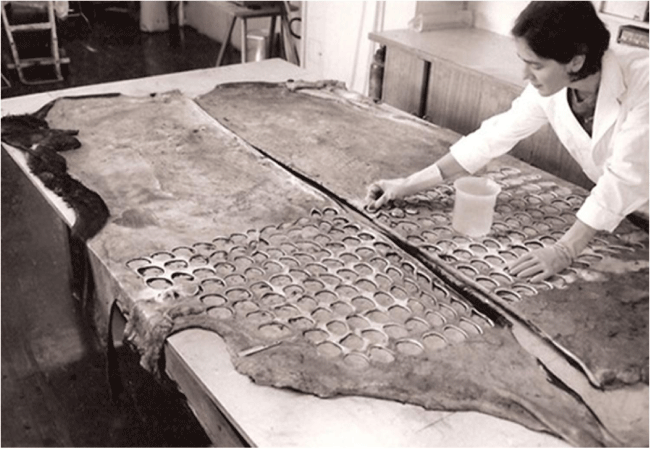
|
Not only were these significant barriers removed, but there were also options for flexible work practices, allowing her to find ways to balance her caring role and her career (work–life balance). This allowed her to continue in the workforce throughout her life, seeing her rise to be one of the world’s leading leather scientists, who in the process delivered immense impact for the leather industry here in Australia and globally. Catherine’s impact has been recognised in the form of significant awards and honours, including The Public Service Medal, for her services to the leather industry and the John Arthur Wilson Memorial Lectureship, which is the most prestigious award in leather research internationally.[45]
Annabelle Duncan (1953–)
Professor Annabelle Duncan (1953–current, active service 1989–2005) was born in Nelson, New Zealand. Annabelle was attracted to a science career at her rural high school, Waimea College in Richmond. She attended local schools, eventually completing an MSc at Otago University before moving to Australia in 1982. Annabelle undertook a PhD in microbiology at La Trobe University and then joined CSIRO, in a largely chemistry-based division, as a research scientist in 1989 and the first female scientist in that research group. Annabelle was promoted to the position of Chief of CSIRO Division of Molecular Science (1999–2005) before moving to senior management roles in the university sector and eventually the position of Vice Chancellor of the University of New England (2014–2019).[49,50] Annabelle was an outstanding leader across these organisations and made major contributions to science diplomacy (Fig. 8).
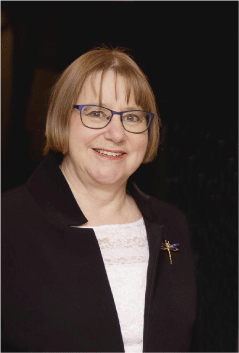
|
Annabelle was the first in her family to go to university. She had strong support from her immediate family but lacked role models for a career in science along with professional female role models in general. Her extended family encouraged her into the traditional female career paths such as secretarial work available in rural NZ. One uncle even advised her that a university education would be wasted as she would end up having children and not using it. She struggled initially with subject and career choice, making several changes early in her undergraduate career, unsure of the career paths available. She credits Margaret Loutit, Professor of Microbiology at the University of Otago, who encouraged her to keep going at university as a critical early mentor. Professor Loutit became a lifetime mentor to Annabelle among many other students. In her interview Annabelle notes several times the importance of leadership mentors from different backgrounds throughout her career.[50] Annabelle was able to help many other students from rural backgrounds into their own careers, particularly in her role as Deputy Vice Chancellor of Research (2010–2013) and Vice-Chancellor and Chief Executive Officer (2014–2019) at the University of New England, based no doubt on her early life experience.
Annabelle’s husband, Bob, also pursued a scientific career, completing a PhD and moving into industrial research himself. This required a flexible approach by Annabelle and her husband towards employment and study, with each of the couple sequentially supporting the other throughout their PhDs and making the transition to career appointments. Together they raised two children, with those challenges amplified by the existing male dominated culture in science. As an example, Annabelle quotes the regular practice of starting team meetings, where she was the only female and the only one with direct family commitments, late in the day. Not appreciating her need to collect her children from creche, Annabelle often missed the important wrap-up stage of the meeting when they ran overtime. She states ‘[she] would just have to leave those meetings early. They were the sorts of things where people didn’t understand the juggle, because they have never had to do it.’[50]
In March 1990 a senior official from the Department of Foreign Affairs and Trade (DFAT) contacted CSIRO to enquire whether the Organisation had a microbiologist who was qualified and willing to provide expert scientific advice to the Australian delegation at upcoming ad hoc meetings to investigate the verification regime for the Biological Weapons Convention (Convention on the Prohibition of the Development, Production, and Stockpiling of Bacteriological (Biological) and Toxin Weapons and on their Destruction). Dr Annabelle Duncan, then a Research Scientist in the Division of Chemicals and Polymers, accepted the challenge and began her work in April 1990. The verification regime was developed but has never been ratified. Her international reputation as a science diplomat led to her invitation to participate in the United Nations Special Commission inspections of biological facilities in Iraq. She made three visits to Iraq, initially as an Inspector, then as Team Leader and finally in 1995 as Deputy Chief Inspector.[50]
Advancement in scientific organisations, and transition to senior management have generally followed a linear path often dependent on high publication rates. Annabelle Duncan did not follow the traditional career trajectory, rather she developed a goal-oriented career, solving the problems presented, initially in research projects and later in management, without large numbers of papers. She also was a leader in CSIRO during the major transition from discipline-based units to multidisciplinary teams, a difficult management challenge in itself. She refers to this challenge and how she overcame it during her career by building an outstanding record of achievement in team leadership in multiple environments, rather than the conventional measures of merit. ‘I really enjoyed the greater interactions with people. I like that. I like working with people, and I like trying to find solutions to people problems.’[50] Often these were outside the immediate organisation and in environments where results were valued over publication rates. For her services to science and weapons control, Annabelle has received such distinguished awards as the Public Service Medal and an Honorary Doctor of Science (DSc) from Murdoch University.[49]
We can see in this brief commentary on Annabelle Duncan’s career that she has faced several of the barriers referred to in this paper. She came from a rural background with no role model for a science career. Mentorship was critical to her ability to enter and build her successful career. An egalitarian and flexible marriage partner aided her to raise her family while achieving notable success. Annabelle took on large and demanding multidisciplinary projects seeking always to solve problems. Importantly Annabelle has shown that flexible networked career pathways are important, and perhaps necessary, in succeeding in otherwise gendered hierarchical organisations.
Conclusion
As is evident from the stories we have presented here, historically women have faced numerous, and almost insurmountable barriers in establishing careers in Australian chemistry at CSIR/CSIRO. Women were not always perceived as equals, regardless of their tertiary qualifications, work experience or number of publications achieved, often leading to bias against their recruitment, or award and promotion cases. A lack of flexible working options and a bias against ‘ticking biological clocks’[11] further posed a challenge to working mothers with caring responsibilities or those aspiring to have a family and remain in the workplace. Scarce mentorship and networking opportunities have also excluded women from the ‘Boy’s Club’[16,19] and posed further challenges for women in these male dominated environments who were attempting to progress their careers.
Fortunately, both legally and culturally, society has shifted towards inclusion, increasing diversity and striving for equity in the workplace. Most of the tools for direct discrimination have been removed, although forms of indirect discrimination remain. Workplaces such as CSIRO have recognised that there is still much work to do to achieve an equitable workplace. Women in CSIRO are still underrepresented in research staff, particularly at higher levels of the organisation and influential boards and committees. Additionally, gender balance (defined as 40:60 in either direction) was projected in the SAGE Athena Swan Institution application by CSIRO to only be achieved by 2047 for total research staff.[11]
To address this, CSIRO has undertaken a self-evaluation, including assessing the gender balance of the staff at each level, current policy and practice and understanding the culture at the organisation. Based on grounded data of the institute, CSIRO has developed 90 proposed actions to be completed by December 2023, designed to drive systemic, long-term change. These focus on supporting and advancing women’s careers, improving work–life balance and fostering mentorship and outreach programs. Several of these overarching aims include: ‘remov[ing] systemic barriers to workforce diversification’, ‘neutralis[ing] the carer’s penalty’, ‘ensur[ing] gender pay equity’ and ‘implement[ing] collective responsibility for diversity and inclusion at CSIRO.’[11]
We’ve come a long way from barring women from science; women are now recognised as valuable members of the workforce, capable of delivering impact to their chosen field. Although there are still many challenges, opportunities grow as more workplaces strive towards gender equity, inclusiveness and family friendly policies. For this progress, we must acknowledge the trail blazing women who came before us. It is thanks to their efforts that today we are able to stand on their shoulders and to continue to strive for equity in the workplace as well as make our own contributions to chemistry.
Supplementary material
Supplementary material is available online.
Data availability
Data sharing is not applicable to this article as no new data were created or analysed in this study.
Conflicts of interest
The authors declare no conflicts of interest.
Declaration of funding
Authors with to acknowledge the postdoctoral fellowship awarded to NM by the CSIRO.
Ethics statement
The Ethics Review Board of Swinburne’s Human Ethics Committee approved this study (SHR Project 2016/304). Research was undertaken in accordance with approved protocols including seeking appropriate informed consent of participants.
Acknowledgements
We sincerely thank Isabel Joy Bear, Enid Plante, Catherine Anne Money and Annabelle Duncan for sharing their stories and being a source of inspiration for women everywhere. We would like to extend our thanks and gratitude towards their family members, including Guy Toner and Dianne Wright for their assistance in preparing this manuscript and sharing the stories on behalf of these trail blazing women. We also thank Kerrie Mullins-Gunst for her insightful discussions.
References
[1] Australian Human Rights Commission. Direct Discrimination. 2017. Available at https://humanrights.gov.au/quick-guide/12026#:~:text=Direct discrimination happens when a,background or certain personal characteristics[2] Alvarez AJ. Writing about women in the history of science: a study of women workers at the Council of Scientific and Industrial Research in the 1930s and 1940s. Master’s Thesis, The University of Melbourne, Melbourne, Vic., Australia; 1993. Available at https://cat2.lib.unimelb.edu.au/record=b1825869~S30
[3] Commonwealth Public Service Act 1922 (No. 21, 1922), s49. Available at http://classic.austlii.edu.au/au/legis/cth/num_act/cpsa1922211922309/
[4] Sawer M. The long, slow demise of the “marriage bar”. Inside Story. 2016. Available at https://insidestory.org.au/the-long-slow-demise-of-the-marriage-bar/
[5] Sawer M. Removal of the Commonwealth Marriage Bar A documentary history. Centre for Research in Public Sector Management, University of Canberra; 1997. Available at https://catalogue.nla.gov.au/Record/2965854
[6] CSIR Science and Industry Research Act (1926), s14A(2). Available at http://classic.austlii.edu.au/au/legis/cth/num_act/saira1926201926306/
[7] Science and Industry Research Act 1949 (NO 13, 1949), s22 (1). Available at http://classic.austlii.edu.au/au/legis/cth/num_act/saira1949131949306/
[8] CSIR Archives. Executive Committee minutes, meeting 645. 1947.
[9] CSIRO Archives. Executive Committee minutes, meeting 153. 1958.
[10] Wolff H. CSIRO Annual Reports 1916–2000. 2020. Available at https://csiropedia.csiro.au/csiro-annual-reports-1916-2000/
[11] CSIRO. Science in Australia Gender Equity Athena Swan Institution application Bronze Award – CSIRO. 2018. Available at https://sciencegenderequity.org.au/application/athena-swan-bronze-award-application-csiro/
[12] National Museum of Australia. Defining moments: Equal pay for women. 2021. Available at https://www.nma.gov.au/defining-moments/resources/equal-pay-for-women
[13] Australian Bureau of Statistics. Gender indicators; 2021. Available at https://www.abs.gov.au/statistics/people/people-and-communities/gender-indicators-australia/latest-release
| Crossref |
[14] Pickering JF. Gender Dynamics in the Management of Commercial and Public Biotechnology Organisations. PhD Thesis, Swinburne University of Technology, Melbourne, Vic., Australia; 2015. Available at https://researchbank.swinburne.edu.au/file/d86b4417-266b-40aa-b165-c573a2d516ba/1/Janine%20Fay%20Pickering%20Thesis.pdf
[15] Australian Human Rights Commission. Indirect Discrimination. 2017. Available at https://humanrights.gov.au/quick-guide/12049#:~:text=Indirect discrimination occurs when there,who share a particular attribute
[16] A Kopinathan, L Weaver, K Locock, Be a catalyst for change: breaking down barriers to maximise Australian female talent in chemistry. Aust J Chem 2020,
| Be a catalyst for change: breaking down barriers to maximise Australian female talent in chemistry.Crossref | GoogleScholarGoogle Scholar |
[17] Australian Academy of Science. Women in STEM Decadal Plan. 2019. Available at https://www.science.org.au/files/userfiles/support/reports-and-plans/2019/gender-diversity-stem/women-in-STEM-decadal-plan-final.pdf
[18] Male Champions of Change. Harnessing Our Innovation Potential: Gender Equality in STEM. 2019. Available at https://championsofchangecoalition.org/wp-content/uploads/2019/08/Harnessing-Our-Innovation-Potential_Stem-Survey-Report-2019.pdf
[19] S Durbin, Creating Knowledge through Networks: a Gender Perspective. Gend Work Organ 2011, 18, 90.
| Creating Knowledge through Networks: a Gender Perspective.Crossref | GoogleScholarGoogle Scholar |
[20] Ward C, CSIRO. Isabel ‘Joy’ Bear. CSIROpedia. 2021. Available at https://csiropedia.csiro.au/Bear-Isabel-Joy/
[21] Australian Centre for the Moving Image. Dr Isabel Joy Bear. 2008. Available at https://www.acmi.net.au/works/116668--dr-isabel-joy-bear/
[22] IJ Bear, RG Thomas, Genesis of petrichor. Geochim Cosmochim Acta 1966, 30, 869.
| Genesis of petrichor.Crossref | GoogleScholarGoogle Scholar |
[23] IJ Bear, RG Thomas, Nature of Argillaceous Odour. Nature 1964, 201, 993.
| Nature of Argillaceous Odour.Crossref | GoogleScholarGoogle Scholar |
[24] Poynton H. The smell of rain: how CSIRO invented a new word. The Conversation. 2015. Available at https://theconversation.com/the-smell-of-rain-how-csiro-invented-a-new-word-39231
[25] Kelly F. Vale Joy Bear: remembering the scientist behind petrichor. CSIROscope. 2021. Available at https://blog.csiro.au/vale-joy-bear/
[26] Wolff H, Plante EC. CSIROpedia. 2020. Available at https://csiropedia.csiro.au/enid-plante/
[27] Plante EC, Spurling T, Swift J. Enid Plante, interviewed by Tom Spurling and Jean Swift, 17 January 1986. Swinburne Commons; 1986.
[28] EC Plante, KL Sutherland, The physical chemistry of flotation. 10. The separation of ergot from rye. J Phys Chem 1944, 48, 203.
[29] Almond JN, Holmes BM, Plante EC. An examination of some Australian hardwood charcoals with special reference to their suitability for charcoal gas producers. Melbourne: Council for Scientific and Industrial Research; 1940.
| Crossref |
[30] EC Plante, An examination of some Australian hardwood charcoals with special reference to their suitability for charcoal gas producers. Part. 2. J Counc Sci Ind Res 1941, 14, 191.
[31] EC Plante, KL Sutherland, Separation of ergot from rye corn. J Counc Sci Ind Res 1943, 16, 28.
[32] Plante EC. Flotation tests on graphite ores from Uley and Koppio. Melbourne, Vic.: CSIR (Australia) Division of Industrial Chemistry; 1943. Available at https://publications.csiro.au/publications/publication/PIlegacy:4461
[33] Plante EC. Flotation of gypsum and silica from salt. Melbourne, VIC: CSIR (Australia) Division of Industrial Chemistry; 1944. https://publications.csiro.au/publications/publication/PIlegacy:4465
[34] Plante EC. Emulsions and emulsifying agents with special reference to DDT. In: Inter-Divisional Committee on Toxicology: some papers presented at the second meeting held in Canberra in July 1945. Council for Scientific and Industrial Research; 1946. pp. 66–73. Available at https://publications.csiro.au/publications/publication/PIlegacy:4148
[35] Plante EC. The preparation of DDT emulsions. Melbourne, Vic.: CSIR Division of Industrial Chemistry; 1945. Available at https://publications.csiro.au/publications/publication/PIlegacy:3625
[36] EC Plante, Emulsions and emulsifying agents with special reference to D.D.T. Aust J Sci 1946, 8, 111.
[37] EC Plante, The flotation of fluorite. Tech Publ Am Inst Min Metall Eng 1947, 2163, 1.
[38] EC Plante, Flotation of unoxidized and oxidized sulphide minerals – antimonite, arsenopyrite, covellite, lollingite, marcasite, orpiment, pyrrhotite and tetrahedrite. Tech Publ Am Inst Min Metall Eng 1948, 2298, 1.
[39] EC Plante, KL Sutherland, Effects of oxidation of sulphide minerals on their flotation properties. Tech Publ Am Inst Min Metall Eng 1948, 2297, 1.
[40] CSIRO. Data to aid human resources policy formulation. CoResearch 1–1. 1988. Available at https://csiropedia.csiro.au/wp-content/uploads/2018/09/coresearch_1988.pdf
[41] CSIRO. CSIRO child care centres. CoResearch 6–6. 1989. Available at https://csiropedia.csiro.au/wp-content/uploads/2018/09/coresearch_1989.pdf
[42] CSIRO. Child care update. CoResearch 8–8. 1992. Available at https://csiropedia.csiro.au/wp-content/uploads/2018/09/coresearch_1992.pdf
[43] CSIRO. CSIRO takes lead in motherhood statements (and backs them with money). CoResearch 1–1. 1991. Available at https://csiropedia.csiro.au/wp-content/uploads/2018/09/coresearch_1991.pdf
[44] CSIRO. Care for kids, and keep your career options open. CoResearch 8–8. 1991. Available at https://csiropedia.csiro.au/wp-content/uploads/2018/09/coresearch_1991.pdf
[45] Ward CW. Catherine Anne Money. CSIROpedia. 2011. Available at https://csiropedia.csiro.au/money-catherine-anne/
[46] Money C, Spurling T, Healy T. Catherine Money, interviewed by Tom Spurling and Terry Healy, 8 December 2021. Available at https://csiropedia.csiro.au/interview-with-catherine-money/
[47] CSIRO. Looking for the answers. CoResearch 6–6. 1975. Available at https://csiropedia.csiro.au/wp-content/uploads/2018/09/coresearch_1975.pdf
[48] Burkett E. Women’s rights movement. Encyclopedia Britannica. 2022. Available at https://www.britannica.com/event/womens-movement
[49] Wolff H. Professor Annabelle Duncan. 2018. Available at https://csiropedia.csiro.au/professor-annabelle-duncan/
[50] Duncan A, Spurling T, Healy T. Annabelle Duncan, interviewed by Tom Spurling and Terry Healy, 6 February 2019. Available at https://csiropedia.csiro.au/interview-with-annabelle-duncan/
1 Spurling T, Wright D, Wright A. Interview with Diane Wright held on 23 January 2022. Unpublished.
2 Spurling T, Wright D, Wright A. Interview with Diane Wright held on 23 January 2022. Unpublished.
3 Internal CSIRO memo. Joy Bear Reference from Richard (Dick) Grenfell to Mr. I. E. Newnham. 1967. Unpublished.
4 Internal CSIRO memo. Joy Bear Reference from Richard (Dick) Grenfell to Mr. I. E. Newnham. 1967. Unpublished.


